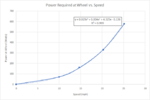EbikeTestLab
Member
Good Morning EBR folks! I wanted to test the accuracy and repeatability of my road load testing and have some fun with tire pressures. Therefore, I setup my Magnum Metro+ just like the last test, but I aired up the tires to 90 psi and ran the 20 mile per hour road load measurement test. I then repeated the same 20 mph road load test at 70 psi, 50 psi, and 30 psi. The results were interesting. From my previous testing, the power needed to maintain 20 mph at the wheels was 323 watts with the tires at 80 psi. At 90 psi, the power needed came out to 315 watts (that's more repeatable than I thought it would be). Here's the full chart of power vs. tire pressure:

The power needed to maintain 20 mph increases dramatically from 70 psi to 50 psi, and even more power is needed at 30 psi. How does this affect range?

A drop from 90 psi to 70 psi equals a 5% penalty in range. From 90 to 50 psi yields a 12.7% penalty, and going down to 30 psi increases that penalty to 18%.
I like to keep my tires at 80 psi (the sidewall lists a range of 50 to 85 psi) but that does make for a firmer ride than say 50 psi. However, my commute is 35 miles and I need all the range I can get to not run the battery too low. Find what works for you and your ride!
The power needed to maintain 20 mph increases dramatically from 70 psi to 50 psi, and even more power is needed at 30 psi. How does this affect range?
A drop from 90 psi to 70 psi equals a 5% penalty in range. From 90 to 50 psi yields a 12.7% penalty, and going down to 30 psi increases that penalty to 18%.
I like to keep my tires at 80 psi (the sidewall lists a range of 50 to 85 psi) but that does make for a firmer ride than say 50 psi. However, my commute is 35 miles and I need all the range I can get to not run the battery too low. Find what works for you and your ride!
